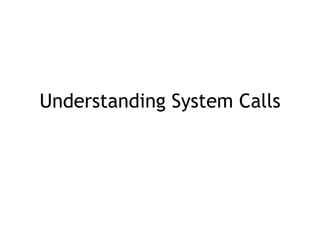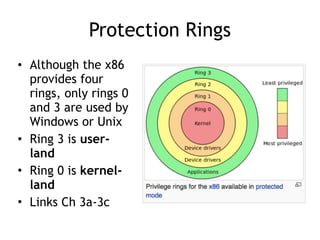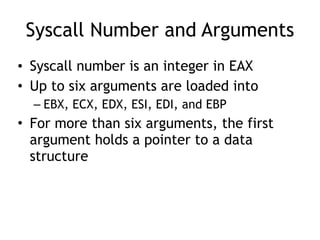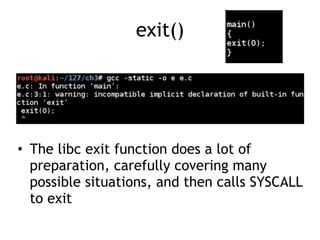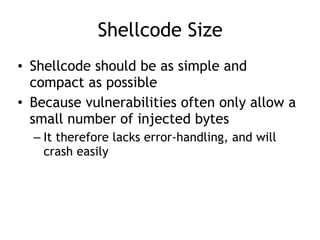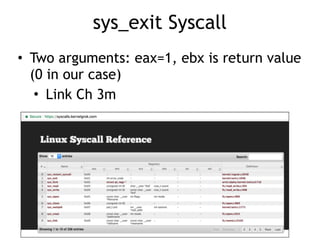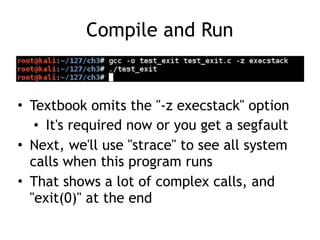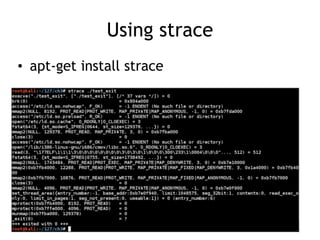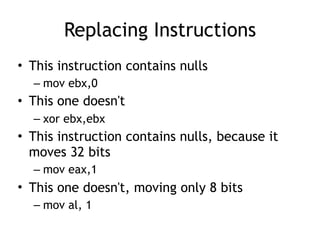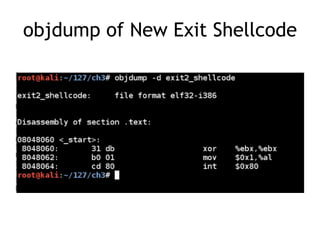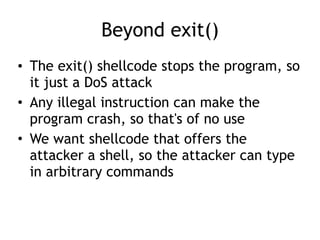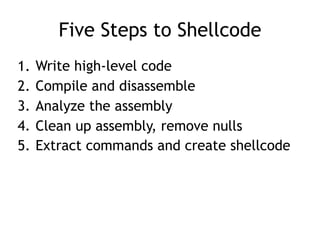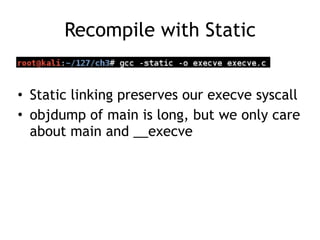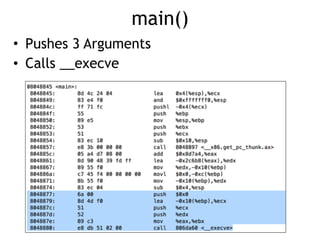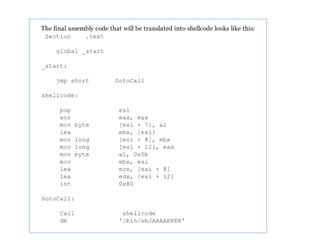CNIT 127 Ch 3: Shellcode
- 1. CNIT 127: Exploit Development Ch 3: Shellcode Updated 2-2-18
- 2. Topics • Protection rings • Syscalls • Shellcode • nasm Assembler • ld GNU Linker • objdump to see contents of object files • strace System Call Tracer • Removing Nulls • Spawning a Shell
- 4. Shellcode • Written in assembler • Translated into hexadecimal opcodes • Intended to inject into a system by exploiting a vulnerability • Typically spawns a root shell, but may do something else
- 5. System Calls (or Syscalls) • Syscalls directly access the kernel, to: – Get input – Produce output – Exit a process – Execute a binary file – And more • They are the interface between protected kernel mode and user mode
- 6. Protection Rings • Although the x86 provides four rings, only rings 0 and 3 are used by Windows or Unix • Ring 3 is user- land • Ring 0 is kernel- land • Links Ch 3a-3c
- 7. Protecting the Kernel • Protected kernel mode – Prevents user applications from compromising the OS • If a user mode program attempts to access kernel memory, this generates an access exception • Syscalls are the interface between user mode and kernel mode
- 8. Libc • C library wrapper • C functions that perform syscalls • Advantages of libc – Allows programs to continue to function normally even if a syscall is changed – Provides useful functions, like malloc – (malloc allocates space on the heap) • See link Ch 3d
- 9. Syscalls use INT 0x80 1. Load syscall number into EAX 2. Put arguments in other registers 3. Execute INT 0x80 4. CPU switches to kernel mode 5. Syscall function executes
- 10. Syscall Number and Arguments • Syscall number is an integer in EAX • Up to six arguments are loaded into – EBX, ECX, EDX, ESI, EDI, and EBP • For more than six arguments, the first argument holds a pointer to a data structure
- 11. exit() • The libc exit function does a lot of preparation, carefully covering many possible situations, and then calls SYSCALL to exit
- 12. Disassembling exit • gdb e – disassemble main – disassemble exit – disassemble __run_exit_handlers • All that stuff is error handling, to prepare for the syscall, which is at the label _exit • disassemble _exit
- 13. Disassembling _exit • syscall 252 (0xfc), exit_group() (kill all threads) • syscall 1, exit() (kill calling thread) – Link Ch 3e
- 14. Writing Shellcode for the exit() Syscall
- 15. Shellcode Size • Shellcode should be as simple and compact as possible • Because vulnerabilities often only allow a small number of injected bytes – It therefore lacks error-handling, and will crash easily
- 16. Seven Instructions • exit_group • exit
- 17. sys_exit Syscall • Two arguments: eax=1, ebx is return value (0 in our case) • Link Ch 3m
- 18. Simplest code for exit(0)
- 19. nasm and ld • nasm creates object file • ld links it, creating an executable ELF file
- 20. objdump • Shows the contents of object files
- 21. C Code to Test Shellcode • From link Ch 3k • Textbook version explained at link Ch 3i
- 22. Compile and Run • Textbook omits the "-z execstack" option • It's required now or you get a segfault • Next, we'll use "strace" to see all system calls when this program runs • That shows a lot of complex calls, and "exit(0)" at the end
- 23. Using strace • apt-get install strace
- 25. Getting Rid of Nulls • We have null bytes, which will terminate a string and break the exploit
- 26. Replacing Instructions • This instruction contains nulls – mov ebx,0 • This one doesn't – xor ebx,ebx • This instruction contains nulls, because it moves 32 bits – mov eax,1 • This one doesn't, moving only 8 bits – mov al, 1
- 27. OLD NEW
- 28. objdump of New Exit Shellcode
- 29. Spawning a Shell
- 30. Beyond exit() • The exit() shellcode stops the program, so it just a DoS attack • Any illegal instruction can make the program crash, so that's of no use • We want shellcode that offers the attacker a shell, so the attacker can type in arbitrary commands
- 31. Five Steps to Shellcode 1. Write high-level code 2. Compile and disassemble 3. Analyze the assembly 4. Clean up assembly, remove nulls 5. Extract commands and create shellcode
- 32. fork() and execve() • Two ways to create a new process in Linux • Replace a running process – Uses execve() • Copy a running process to create a new one – Uses fork() and execve() together
- 33. C Program to Use execve() • See link Ch 3l
- 34. Recompile with Static • Static linking preserves our execve syscall • objdump of main is long, but we only care about main and __execve
- 35. main() • Pushes 3 Arguments • Calls __execve
- 36. Man Page • execve() takes three arguments
- 37. execve() Arguments 1. Pointer to a string containing the name of the program to execute – "/bin/sh" 2. Pointer to argument array – happy 3. Pointer to environment array – NULL
- 38. Objdump of __execve • Puts four parameters into edx, ecx, ebx, and eax • INT 80


